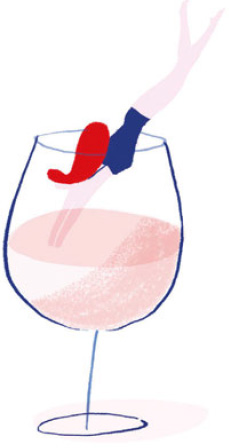
I had been covering wine as a journalist for fifteen years when I began this book, fueled by a sense of frustration that rosé hadn’t received its due. As I write this, in 2016, there are no English-language wine guides in print on the subject of rosé. I have attempted to fill that void in the following pages.
This book tracks rosé’s recent rise from obscurity to pop-culture phenomenon. It presents a brief history of pink wine, outlines the various ways rosé is made, and explores the many styles of rosé produced in nations all over the globe. It highlights distinct regions to know and introduces you to producers and particular wines that have caught my interest.
Because my goal is to challenge the prevailing assumption that one rosé is indistinguishable from the next, I have zeroed in on wines that stand apart from their peers in terms of quality, methodology, or backstory.
Wine is a finite specialty good, and no bottle shop has the capacity to stock every producer on the planet, so—as with any wine guide—I cannot guarantee that every name mentioned in this book will be readily available at a moment’s notice. That said, with just a few rare exceptions, I aimed to include wines with distribution in multiple cities throughout the United States.
At the ends of chapters, I have included images of a selection of the wines discussed, featuring some of the most attractive bottles and labels in rosé-dom. I hope these pages will help you recognize some safe bets on the shelves of your local wine shop.
A good merchant can procure a hard-to-find wine for you—if not from current stock, then by special order. Don’t be shy about requesting one that has piqued your interest. If that fails, ask your wine merchant to recommend something comparable. The descriptions in this book of regions and styles will still inform your tasting experience. If you’ve never sampled a Rosé des Riceys before, one is likely to taste quite similar to another. And for every wine described in these pages, there were five more I wished I’d had the space to include.
Speaking of space, I tried not to bog down the book with explanations of geographical classifications. If you are wondering what an AOP or IGP is, turn to this page for a quick tutorial. If you choose not to wonder, I don’t blame you.
Rosé is largely seasonal. It is produced in limited amounts with the expectation that it will sell out immediately. I tasted vintages that in most cases will not be available to you. So I have left specific years out of the discussion, choosing instead to offer a general sense of what to expect from each wine.
Last but not least, let’s talk price. Rosé is a category that tends toward the affordable, and there are many treasures in the sub-$15 range. In this book, I recommend plenty of those wines, and I don’t hold them to the same stringent standards I apply to $30-to-$50 bottles. A $10 rosé should be merely refreshing and pleasant. A $40 rosé should get your gray matter going with its complexity.
I have also included some of the most precious pinks on the planet, which can sell in the $75 to $100 range (or more, if we’re talking Champagne). This is still reasonable by the standards of the cult wine world. Even with the recent arrival of the luxury class of still rosés, pink continues to represent value.
While I wasn’t able to include every worthy rosé region and winery in the world, this book is a start. After all, most wine encyclopedias don’t give rosé more than a quick nod. I believe it deserves more. So let’s dive in.
